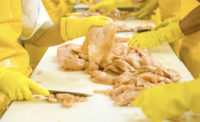Injection and marination systems are notoriously tricky to run — outside of creating a uniform, quick and safe product — but product manufacturers are making continual improvements to their pump consistency, throughput and filtration systems.
“Meeting industry demands for increased throughput, which requires adjustments in injection pressures and can cause problems with uniformity of injection levels in some product, is a constant challenge,” says Lynn Knipe, Ph.D., extension processed meats specialist, The Ohio State University, based in Columbus, Ohio.
Indeed, injectors that insert bone-in product often run into mechanical issues, likely due to high product weights and the resistance these larger cuts put on the injector. In addition, “variable sizes of product going through an injector can sometimes pick up variable levels of brine, resulting in product inconsistencies,” say Cargill Inc. food scientists at the company’s Wichita, Kan., research and development center.
If machines can avoid recycling brine or curing systems that run off meat cuts during the injection process, then they can also better limit surface contamination from pathogens.
“Translocating pathogens — particularly E. coli O157:H7 in beef cuts — when using injectors to enhance meat cuts is an industry challenge,” says Knipe. “For the most part, processors are applying organic acid rinses to the meat cuts prior to the injection process to eliminate surface contamination, due to pathogens, from being pushed into the center of the meat cut.”
According to Knipe, more manufacturers are developing equipment that can respond to industry demands for increased throughput today.
“The ability to hit injection targets more closely and the uniformity of solution distribution in meat cuts have improved over the years,” he says. “As the speed of conveying meat through an injector is increased, the injection pressure also has to be increased to meet the same injection target,” which can result in other quality and injection uniformity problems particularly with smaller cuts of meat.
Filtration systems also continue to become more robust as manufacturers improve their technology. The filtering systems for fat and protein now allow for a more complete use of recycled brine solutions.
“Filtration systems have been improved to remove more particulate from re-circulated brine, and head and manifolds have been designed to enable more thorough and efficient sanitation steps,” says Cargill.
A few manufacturers also have technology that enables the injection of emulsified trimmings in either fresh or cooked applications.
“Pump consistency has also been improved over the years, with many newer machines seeing lower standard deviations on pump percentages,” says Cargill’s food scientists.
Machine improvements can still be made, however, for better detection of clogged needles, in-line scale systems that help to monitor pump levels, and fool-proof assembly (if the machine is not assembled properly, it won’t run to minimize damage), notes Cargill. In addition, it would be a benefit to reduce the number of moving parts.

According to Knipe, some improvements could still be made to reduce the amount of brine that is wasted or not used, either because of the amount of brine that is needed to prime the injector pumps or the brine that that is not recycled because of inadequate filtration systems.
“Also, injection solutions that contain inorganic phosphates pose an environmental hazard when they are flushed through the waste water system,” he says.




Report Abusive Comment